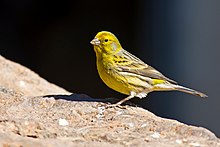Serinus canaria
| Atlantic canary | |
|---|---|
 |
|
| Male in Gran Canaria, Spain | |
| Scientific classification | |
| Kingdom: | Animalia |
| Phylum: | Chordata |
| Class: | Aves |
| Order: | Passeriformes |
| Family: | Fringillidae |
| Genus: | Serinus |
| Species: | S. canaria |
| Binomial name | |
|
Serinus canaria (Linnaeus, 1758) |
|
The Atlantic canary (Serinus canaria) is known worldwide simply as wild canary. It is also called the island canary, canary or common canary, is a small passerine bird belonging to the genus Serinus in the finch family, Fringillidae. It is native to the Canary Islands, the Azores, and Madeira. Wild birds are mostly yellow-green, with brownish streaking on the back. The species is common in captivity and a number of colour varieties have been bred.
This bird is the natural symbol of the Canary Islands, together with the Canary Island date palm.
The wild Atlantic canary can range from 10 to 12 cm (3.9 to 4.7 in) in length, with a wingspan of 21 to 23.7 cm (8.3 to 9.3 in) and a weight of 8.4 to 24.3 g (0.30 to 0.86 oz), with an average of around 15 g (0.53 oz). The male has a largely yellow-green head and underparts with a yellower forehead, face and supercilium. The lower belly and undertail-coverts are whitish and there are some dark streaks on the sides. The upperparts are grey-green with dark streaks and the rump is dull yellow. The female is similar to the male but duller with a greyer head and breast and less yellow underparts. Juvenile birds are largely brown with dark streaks.
It is about 10% larger, longer and less contrasted than its relative the European serin, and has more grey and brown in its plumage and relatively shorter wings.
The song is a silvery twittering similar to the songs of the serin and citril finch.
Hybridization with white-rumped seedeater has been noted by Antonio Arnaiz-Villena et al.
The Atlantic canary was classified by Linnaeus in 1758 in his Systema Naturae. Linnaeus originally classified the Atlantic canary as a subspecies of the European serin and assigned them to the genus Fringilla. Decades later, Cuvier reclassified them into the genus Serinus and there they have remained. The Atlantic canary's closest relative is the European serin, and the two can produce on average 25% fertile hybrids if crossed.
...
Wikipedia

